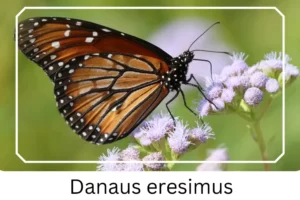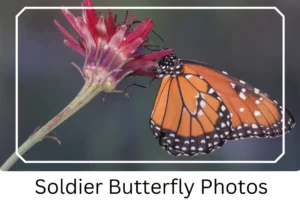Soldier (Danaus eresimus)
The Soldier Butterfly, scientifically known as Danaus eresimus, is a fascinating species of butterfly notable for its striking dark orange coloration and presence across various regions of the Americas. These butterflies offer a unique spectacle due to their leisurely flight patterns, making them a favorite among butterfly watchers. Their approachability and distinctive appearance have made them a subject of interest for both casual observers and scientific research.
Scientific Classification
- Family: Nymphalidae
- Genus: Danaus
- Common names: Tropical Queen
- Scientific Name: Danaus eresimus
Overview
Soldier Butterflies inhabit a range of subtropical environments, thriving in open spaces where their host plants are abundant. They are part of a complex ecosystem, playing a significant role in the pollination of various plant species. This butterfly species exhibits intriguing behaviors and life cycle stages, from egg to caterpillar, pupa, and finally, the adult butterfly. Each stage offers unique identification features, contributing to the butterfly’s survival and reproduction strategies.
Description and Identification
Caterpillar
The Soldier Butterfly caterpillar is visually striking, with a black body adorned with white and yellow stripes. It features three pairs of fleshy filaments in black, positioned on the head, thorax, and abdomen, respectively. These caterpillars are also marked by a subdorsal row of yellowish-tan spots, adding to their distinctive appearance.
Pupa
The pupa, or chrysalis stage, is characterized by a bright green color, allowing it to blend seamlessly with foliage. It suspends itself under leaves, adopting a form that closely resembles that of the monarch butterfly’s chrysalis, posing a challenge for observers trying to differentiate between the two species.
Adult Butterfly
Sexual Dimorphism: Sexual dimorphism in the Soldier Butterfly is subtly present, with males sporting a black scent patch on their secondary wings, a feature absent in females.
Color and Appearance: When their wings are spread, adults display a dark reddish-brown hue with possible white submarginal spots on the forewings. The intricate black venations across the wings add to their beauty. The underside shows a similar pattern, highlighted by a band of square spots. A subspecies, Danaus eresimus flexaure, exhibits additional white markings on the ventral side of its secondary wings.

 Average Wingspan: The Soldier Butterfly boasts an average wingspan ranging from 2½ to 3½ inches (64–76 mm), allowing for a slow, fluttering flight over short distances.
Average Wingspan: The Soldier Butterfly boasts an average wingspan ranging from 2½ to 3½ inches (64–76 mm), allowing for a slow, fluttering flight over short distances.
Flight Pattern: Their flight is characterized by slow, deliberate movements, often covering short distances, which makes them particularly visible and approachable to humans.
Eggs
The eggs of the Soldier Butterfly are a bright orange hue, delicately laid on the leaves of host plants, signaling the beginning of the next generation.
Quick Facts | |
| Distribution | Southern Florida, South Texas, the West Indies, and Central America to Brazil. |
| Habitat | Prefers open, subtropical areas such as citrus groves, weedy water edges, and seasonally dry fields and forests. |
| Lifespan of Adults | Estimated between 6 to 9 months. |
| Host Plants | Utilizes milkweeds and milkweed vines, including Strangler vine, White vine, and West Indian pinkroot. |
| Adult Diet | Primarily consists of flower nectar. |
How to Identify Soldier Butterfly?
Identifying Soldier Butterflies involves observing several key characteristics. Their dark orange wings, adorned with distinct black venations and the potential presence of white spots, are hallmark identifiers. Males can be distinguished by the black scent patch on their secondary wings, a feature not found in females. The eggs’ bright orange color and the caterpillar’s unique banded pattern further aid in identification. When observing the pupa, its bright green color and the shape that mimics the monarch butterfly’s chrysalis are notable. Familiarity with these features, coupled with an understanding of their preferred habitats and host plants, can greatly enhance identification accuracy and enjoyment of observing these captivating creatures.
Did You Know?
- Female Soldier Butterflies are capable of producing three or more broods within a single year, showcasing their reproductive versatility.
- The Soldier Butterfly’s ability to mimic the appearance of the monarch butterfly’s chrysalis serves as a defensive strategy against predators, leveraging the monarch’s reputation for being unpalatable.
Conclusion
The Soldier Butterfly, with its vivid colors and fascinating life cycle, is a remarkable creature that adds beauty and diversity to its ecosystem. Understanding and appreciating the intricacies of its existence not only enhances our enjoyment of nature but also underscores the importance of conserving the habitats these butterflies rely on.
Soldier Butterfly Pictures

Scientific Classification

- Family: Nymphalidae
- Genus: Danaus
- Common names: Tropical Queen
- Scientific Name: Danaus eresimus







